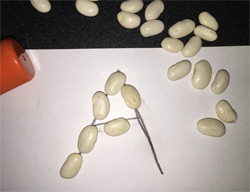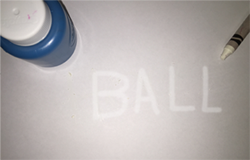10 Spelling Activities for Early Learners

When you tell your child it is time to practice spelling, you may get a range of reactions from “Can’t wait!” to “Do I have to?” Because of a child’s natural inclination to explore and play, it can sometimes be difficult to engage a young child and help them develop a positive attitude toward spelling. Sometimes all you need is a new activity or approach to add to your regular spelling program to reignite enthusiasm for spelling.
Try some of these fun, simple, multi-sensory, and low-stress spelling activities below to jump-start your young speller’s curiosity and confidence. Keep in mind that these activities are meant to be fun and encourage enthusiasm and interest in spelling. If your student shows signs of unwillingness or gets frustrated or discouraged, try a different activity or take a break. While these games are fun and engaging ways to practice individual words together, you should not depend on games like these to teach spelling. Your student’s regular spelling program should present words in context to help your student develop a visual memory of the words through writing.
Spelling Activities for Early Learners
1) Finger Pencils
Take a break from pencil and paper and let your child try their hand at writing words using yogurt, pudding, or finger paint spread onto the bottom of a baking sheet or disposable pan. If it’s summer time, head out to the sandbox to play with words. For a colorful twist, line the bottom of a pan with colored paper and then cover with a thin layer of salt, flour, or sand to create a myriad of rainbow words. If your child does not like the feel or “mess” of finger paint or sand, put some in a plastic gallon bag (remove as much air as possible) and seal it tightly. Have them use their finger or a cotton swab and press on the bag to make the words appear. Erasing words is easy as a swipe of the hand with these techniques, but getting them to stop writing words may not be so easy!

2) Writer’s “Block”
Grab any building blocks your child already plays with at home. Have them start by building letters with the blocks. They can then move on to spelling simple words with the letters they have built. Once they have built a word, have them trace over the letters. Create fun games out of building and tracing the letters. Some ideas might be: every time they trace a letter have them add a new layer of blocks to it, or see if they can build a letter vertically instead of laying the blocks out flat.
3) Giant Words
Carve out some table space for these activities because you will be able to see your child spelling from across the room! Cook some spaghetti noodles (be sure to let them cool first) and coat with a bit of oil so they do not stick together. Have your child build words with the noodles on wax paper. They can use whole noodles or you may decide to cut them in half, thirds, or quarters and experiment with different sizes for the letters. This same concept can be accomplished by having your child roll and form letters out of dough or clay. If you have alphabet cookie cutters they can cut out the letters and then put the letters together to spell words. No time for the mess and clean up? Look for some chenille stems (also known as pipe cleaners) at your local craft store and have your child bend, twist, and turn them to form letters and then words. Whichever technique your child decides to use, when they are finished, have them trace over the words with their finger to help develop their visual memory.
4) Texture Words
This activity should be done gradually over time. It is a fun multi-sensory introduction to letter recognition and can later be used for spelling practice of short words (2-3 letters each). Write one letter of the alphabet on an index card with a marker. If you feel your child has the confidence and dexterity, they can write the letters. Next, have your child glue raised objects such as dried beans, corn, peas, lentils, sequins, small buttons, cotton balls, or pompoms on each outlined letter. Allow the cards to dry thoroughly. When all the letters cards are complete, your child can see, say, and trace the letters with their fingers to become familiar with them. When you feel they are ready, your child can manipulate the cards to form two or three letter words and write over the letters with their finger.

5) Sidewalk Spelling
Take your child outside and either choose a spot on the sidewalk or an open spot of concrete you might have on your driveway. If the concrete is dry, take a bucket of water and a paint brush (a one half or two inch bristle-head brush works well). Have your child dip the brush in the bucket of water and write words on the concrete. If it’s not very dry out, mix up some mud in the bucket instead and have your child use the mud to paint the words. If you’re using the water method, have your child trace over the words with chalk. If you’re using mud, have your child collect sticks, rocks, and/or leaves and use those items to place on top of the muddy letters to trace them.
6) Mystery Words
Encourage your child to write words or even a story with a white crayon on white paper. Once complete, have you or your child paint over the paper with water colors to reveal the words or story. By contrast, have your child write words with chalk on black construction paper, gently spray (not soak) with some water, and watch them disappear and then reappear! The words may reappear slightly faded, so your child can simply retrace the words with chalk to make them look bold again.

7) Spelling Through Stories
Create your own fill-in-the-blank story. You can type it on the computer (using a large font) or write it on chart paper or poster board. Let your child have fun filling in the blanks with words while practicing their spelling.
8) Splish, Splash, Spell
Make some homemade bathtub paint (1 cup clear or white baby bubble bath or body wash, 4 tbsp. cornstarch, and a few drops of food coloring). Mix up the paint just before bath time and let your child have fun writing words with fingers or paintbrushes on the tile, tub, or shower door.
9) Shadow Spelling
Pick a room in your house that can easily be made dark and has a wall that is relatively open (if you don’t have an open wall available, you can hang up a light colored sheet or blanket instead). Grab a flashlight or other bright light, that is easy to control, and shine it on the wall. Start by having your child try and make letters with their fingers in front of the light to create shadow letters. See if you and your child can work together to spell some basic two or three letter words. If you have the space, see if you child can create shadow letters with their body by standing in front of the light. Turn this activity into a game by taking turns trying to guess what word the other is spelling with their hands or body. To make it even more challenging, have your child simply trace the letters on the wall using shadows and try to guess the word.
10) Trace n’ Sniff Spelling
On heavyweight paper or cardboard, have your child write words with a glue stick or paint them with homemade glue. Place the paper with the wet and sticky word(s) in a pan or box lid and sprinkle with colored powdered drink mix or gelatin. Spread the powder completely over the words by slightly shaking the pan and allow them to dry thoroughly. Your child can then trace over a word several times by firmly pressing down with their finger for a scented spelling surprise.
BONUS: Swab Spelling
Paint words with cotton swabs. Swabs work best with paint, water colors, or food. Place one swab per color and a small amount of your medium in paper cups, a plastic egg carton, or muffin tins. Depending on the medium selected, you can paint words on paper plates, paper, aluminum foil, or cut-up cardboard. For an extra challenge, have your child “dot” the letters of each word, let them dry, and then use a marker or crayon and trace over them (this works best with paper or cardboard).

The goal of these activities is to add some variety to your spelling program and help your young child feel more relaxed about spelling. Again, keep in mind that these activities are not intended to teach spelling but rather serve as fun alternatives that add variety and interest into practicing words. A well-rounded spelling program that teaches spelling should present words in context to help your student develop a visual memory of the words through writing.